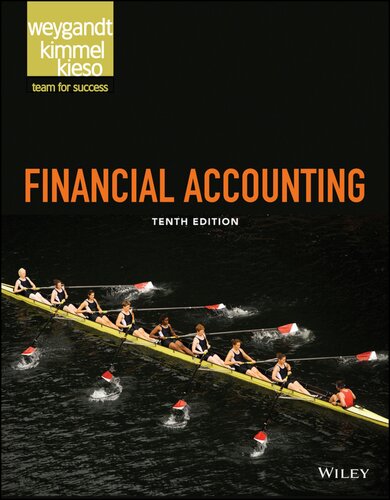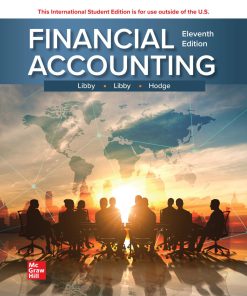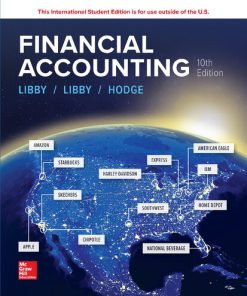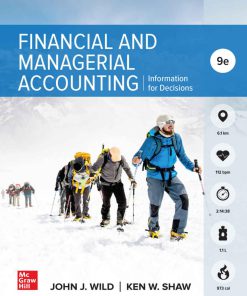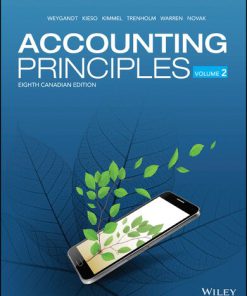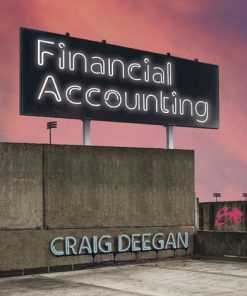Financial Accounting by Jerry, Donald, Paul 9781119305842 1119305845
$50.00 Original price was: $50.00.$25.00Current price is: $25.00.
Financial Accounting Jerry J. Weygandt – Ebook Instant Download/Delivery ISBN(s): 9781119305842,1119305845

Product details:
- ISBN 10: 1119305845
- ISBN 13:9781119305842
- Author: Jerry, Donald, Paul
Financial Accounting
More students get accounting when using Weygandt, Kimmel, Kieso, Financial Accounting, 10th Edition because of the unique Framework of Success created and refined by the authors based on years of teaching and course design experience. In WileyPLUS and in print, clear and relevant exposition, engaging visuals and videos, and valuable end-of-chapter material work together to build students’ confidence and mastery of accounting concepts and skills. The new 10th edition of Financial Accounting by Weygandt, Kimmel, and Kieso continues to provide students with a clear and comprehensive introduction to financial accounting and has been thoroughly updated with extensive digital resources to further enhance student learning and success.
Table contents:
1 Accounting in Action
LO 1 Identify the activities and users associated with accounting.
LO 2 Explain the building blocks of accounting: ethics, principles, and assumptions.
LO 3 State the accounting equation, and define its components.
LO 4 Analyze the effects of business transactions on the accounting equation.
LO 5 Describe the four financial statements and how they are prepared.
LO *6 APPENDIX 1A: Explain the career opportunities in accounting.
Review and Practice
LEARNING OBJECTIVES REVIEW
GLOSSARY REVIEW
PRACTICE MULTIPLE-CHOICE QUESTIONS
PRACTICE EXERCISES
PRACTICE PROBLEM
End-of-Chapter Homework Material
QUESTIONS
BRIEF EXERCISES
DO IT! EXERCISES
EXERCISES
EXERCISES: SET B AND CHALLENGE EXERCISES
PROBLEMS: SET A
PROBLEMS: SET B AND SET C
CONTINUING PROBLEM
COOKIE CREATIONS
EXPAND YOUR CRITICAL THINKING
A Look at IFRS
LO 7 Describe the impact of international accounting standards on U.S. financial reporting.
2 The Recording Process
LO 1 Describe how accounts, debits, and credits are used to record business transactions.
LO 2 Indicate how a journal is used in the recording process.
LO 3 Explain how a ledger and posting help in the recording process.
LO 4 Prepare a trial balance.
Review and Practice
LEARNING OBJECTIVES REVIEW
GLOSSARY REVIEW
PRACTICE MULTIPLE-CHOICE QUESTIONS
PRACTICE EXERCISES
PRACTICE PROBLEM
End-of-Chapter Homework Material
QUESTIONS
BRIEF EXERCISES
DO IT! EXERCISES
EXERCISES
EXERCISES: SET B AND CHALLENGE EXERCISES
PROBLEMS: SET A
PROBLEMS: SET B AND SET C
CONTINUING PROBLEMS
COOKIE CREATIONS
EXPAND YOUR CRITICAL THINKING
A Look at IFRS
LO 5 Compare the procedures for the recording process under GAAP and IFRS.
3 Adjusting the Accounts
LO 1 Explain the accrual basis of accounting and the reasons for adjusting entries.
LO 2 Prepare adjusting entries for deferrals.
LO 3 Prepare adjusting entries for accruals.
LO 4 Describe the nature and purpose of an adjusted trial balance.
LO*5 APPENDIX 3A: Prepare adjusting entries for the alternative treatment of deferrals.
LO* 6 APPENDIX 3B Discuss financial reporting concepts.
Review and Practice
LEARNING OBJECTIVES REVIEW
GLOSSARY REVIEW
PRACTICE MULTIPLE-CHOICE QUESTIONS
PRACTICE EXERCISES
PRACTICE PROBLEM
End-of-Chapter Homework Material
QUESTIONS
BRIEF EXERCISES
DO IT! EXERCISES
EXERCISES
EXERCISES: SET B AND CHALLENGE EXERCISES
PROBLEMS: SET A
PROBLEMS: SET B AND SET C
CONTINUING PROBLEM
COOKIE CREATIONS
EXPAND YOUR CRITICAL THINKING
A Look at IFRS
LO 7 Compare the procedures for adjusting entries under GAAP and IFRS.
4 Completing the Accounting Cycle
LO 1 Prepare a worksheet.
LO 2 Prepare closing entries and a post-closing trial balance.
LO 3 Explain the steps in the accounting cycle and how to prepare correcting entries.
LO 4 Identify the sections of a classified balance sheet.
LO *5 APPENDIX 4A: Prepare reversing entries.
Review and Practice
LEARNING OBJECTIVES REVIEW
GLOSSARY REVIEW
PRACTICE MULTIPLE-CHOICE QUESTIONS
PRACTICE EXERCISES
PRACTICE PROBLEM
End-of-Chapter Homework Material
QUESTIONS
BRIEF EXERCISES
DO IT! EXERCISES
EXERCISES
EXERCISES: SET B AND CHALLENGE EXERCISES
PROBLEMS: SET A
PROBLEMS: SET B AND SET C
CONTINUING PROBLEM
COOKIE CREATIONS
COMPREHENSIVE ACCOUNTING CYCLE REVIEW
EXPAND YOUR CRITICAL THINKING
A Look at IFRS
LO 6 Compare the procedures for the closing process under GAAP and IFRS.
5 Accounting for Merchandising Operations
LO 1 Describe merchandising operations and inventory systems.
LO 2 Record purchases under a perpetual inventory system.
LO 3 Record sales under a perpetual inventory system.
LO 4 Apply the steps in the accounting cycle to a merchandising company
LO 5 Prepare a multiple-step income statement and a comprehensive income statement
LO *6 APPENDIX 5A: Prepare a worksheet for a merchandising company.
LO *7 APPENDIX 5B: Record purchases and sales under a periodic inventory system.
Review and Practice
LEARNING OBJECTIVES REVIEW
GLOSSARY REVIEW
PRACTICE MULTIPLE-CHOICE QUESTIONS
PRACTICE EXERCISES
PRACTICE PROBLEM
End-of-Chapter Homework Material
QUESTIONS
BRIEF EXERCISES
DO IT! EXERCISES
EXERCISES
EXERCISES: SET B AND CHALLENGE EXERCISES
PROBLEMS: SET A
PROBLEMS: SET B AND SET C
CONTINUING PROBLEM
COOKIE CREATIONS
COMPREHENSIVE ACCOUNTING CYCLE REVIEW
EXPAND YOUR CRITICAL THINKING
A Look at IFRS
LO 8 Compare the accounting for merchandising under GAAP and IFRS.
6 Inventories
LO 1 Discuss how to classify and determine inventory.
LO 2 Apply inventory cost flow methods and discuss their financial effects.
LO 3 Indicate the effects of inventory errors on the financial statements.
LO 4 Explain the statement presentation and analysis of inventory.
LO *5 APPENDIX 6A: Apply the inventory cost flow methods to perpetual inventory records.
LO *6 APPENDIX 6B: Describe the two methods of estimating inventories.
Review and Practice
LEARNING OBJECTIVES REVIEW
GLOSSARY REVIEW
PRACTICE MULTIPLE-CHOICE QUESTIONS
PRACTICE EXERCISES
PRACTICE PROBLEM
End-of-Chapter Homework Material
QUESTIONS
BRIEF EXERCISES
DO IT! EXERCISES
EXERCISES
EXERCISES: SET B AND CHALLENGE EXERCISES
PROBLEMS: SET A
PROBLEMS: SET B AND SET C
CONTINUING PROBLEM
COOKIE CREATIONS
COMPREHENSIVE ACCOUNTING CYCLE REVIEW
EXPAND YOUR CRITICAL THINKING
A Look at IFRS
LO 7 Compare the accounting for inventories under GAAP and IFRS.
7 Fraud, Internal Control, and Cash
LO 1 Define fraud and the principles of internal control.
LO 2 Apply internal control principles to cash.
LO 3 Identify the control features of a bank account.
LO 4 Explain the reporting of cash.
Review and Practice
LEARNING OBJECTIVES REVIEW
GLOSSARY REVIEW
PRACTICE MULTIPLE-CHOICE QUESTIONS
PRACTICE EXERCISES
PRACTICE PROBLEM
End-of-Chapter Homework Material
QUESTIONS
BRIEF EXERCISES
DO IT! EXERCISES
EXERCISES
EXERCISES: SET B AND CHALLENGE EXERCISES
PROBLEMS: SET A
PROBLEMS: SET B AND SET C
CONTINUING PROBLEM
COOKIE CREATIONS
COMPREHENSIVE ACCOUNTING CYCLE REVIEW
EXPAND YOUR CRITICAL THINKING
A Look at IFRS
LO 5 Compare the accounting for fraud, internal control, and cash under GAAP and IFRS.
8 Accounting for Receivables
LO 1 Explain how companies recognize accounts receivable.
LO 2 Describe how companies value accounts receivable and record their disposition.
LO 3 Explain how companies recognize, value, and dispose of notes receivable.
LO 4 Describe the statement presentation and analysis of receivables.
Review and Practice
LEARNING OBJECTIVES REVIEW
GLOSSARY REVIEW
PRACTICE MULTIPLE-CHOICE QUESTIONS
PRACTICE EXERCISES
PRACTICE PROBLEM
End-of-Chapter Homework Material
QUESTIONS
BRIEF EXERCISES
DO IT! EXERCISES
EXERCISES
EXERCISES: SET B AND CHALLENGE EXERCISES
PROBLEMS: SET A
PROBLEMS: SET B AND SET C
CONTINUING PROBLEM
COOKIE CREATIONS
COMPREHENSIVE ACCOUNTING CYCLE REVIEW
EXPAND YOUR CRITICAL THINKING
A Look at IFRS
LO 5 Compare the accounting for receivables under GAAP and IFRS.
9 Plant Assets, Natural Resources, and Intangible Assets
LO 1 Explain the accounting for plant asset expenditures
LO 2 Apply depreciation methods to plant assets
LO 3 Explain how to account for the disposal of plant assets
LO 4 Describe how to account for natural resources and intangible assets
LO 5 Discuss how plant assets, natural resources, and intangible assets are reported and analyzed.
LO *6 APPENDIX 9A Explain how to account for the exchange of plant assets.
Review and Practice
LEARNING OBJECTIVES REVIEW
GLOSSARY REVIEW
PRACTICE MULTIPLE-CHOICE QUESTIONS
PRACTICE EXERCISES
PRACTICE PROBLEMS
End-of-Chapter Homework Material
QUESTIONS
BRIEF EXERCISES
DO IT! EXERCISES
EXERCISES
EXERCISES: SET B AND CHALLENGE EXERCISES
PROBLEMS: SET A
PROBLEMS: SET B AND SET C
CONTINUING PROBLEM
COOKIE CREATIONS
COMPREHENSIVE ACCOUNTING CYCLE REVIEW
EXPAND YOUR CRITICAL THINKING
A Look at IFRS
LO 7 Compare the accounting for long-lived assets under GAAP and IFRS.
10 Liabilities
LO 1 Explain how to account for current liabilities.
LO 2 Describe the major characteristics of bonds.
LO 3 Explain how to account for bond transactions.
LO 4 Explain how to account for long-term notes payable.
LO 5 Discuss how liabilities are reported and analyzed.
LO *6 APPENDIX 10A: Apply the straight-line method of amortizing bond discount and bond premium.
LO *7 APPENDIX 10B: Apply the effective-interest method of amortizing bond discount and bond premium.
Review and Practice
LEARNING OBJECTIVES REVIEW
GLOSSARY REVIEW
PRACTICE MULTIPLE-CHOICE QUESTIONS
PRACTICE EXERCISES
PRACTICE PROBLEM
End-of-Chapter Homework Material
QUESTIONS
BRIEF EXERCISES
DO IT! EXERCISES
EXERCISES
EXERCISES: SET B AND CHALLENGE EXERCISES
PROBLEMS: SET A
PROBLEMS: SET B AND SET C
CONTINUING PROBLEM
COOKIE CREATIONS
COMPREHENSIVE ACCOUNTING CYCLE REVIEW
EXPAND YOUR CRITICAL THINKING
A Look at IFRS
LO 8 Compare the accounting for liabilities under GAAP and IFRS.
11 Corporations: Organization, Stock Transactions, and Stockholders’ Equity
LO 1 Discuss the major characteristics of a corporation.
LO 2 Explain how to account for the issuance of common, preferred, and treasury stock.
LO 3 Explain how to account for cash dividends, stock dividends, and stock splits.
LO 4 Discuss how stockholders’ equity is reported and analyzed.
LO *5 APPENDIX 11A: Describe the use and content of the stockholders’ equity statement.
LO 6 APPENDIX 11B: Compute book value per share.
Review and Practice
LEARNING OBJECTIVES REVIEW
GLOSSARY REVIEW
PRACTICE MULTIPLE-CHOICE QUESTIONS
PRACTICE EXERCISES
PRACTICE PROBLEM
End-of-Chapter Homework Material
QUESTIONS
BRIEF EXERCISES
DO IT! EXERCISES
EXERCISES
EXERCISES: SET B AND CHALLENGE EXERCISES
PROBLEMS: SET A
PROBLEMS: SET B AND SET C
CONTINUING PROBLEM
COOKIE CREATIONS
COMPREHENSIVE ACCOUNTING CYCLE REVIEW
EXPAND YOUR CRITICAL THINKING
A Look at IFRS
LO 7 Compare the accounting for stockholders’ equity under GAAP and IFRS.
12 Statement of Cash Flows
LO 1 Discuss the usefulness and format of the statement of cash flows.
LO 2 Prepare a statement of cash flows using the indirect method.
LO 3 Analyze the statement of cash flows.
LO *4 APPENDIX 12A: Prepare a statement of cash flows using the direct method.
LO *5 APPENDIX 12B: Use a worksheet to prepare the statement of cash flows using the indirect method.
LO *6 APPENDIX 12C: Use the T-account approach to prepare a statement of cash flows.
Review and Practice
LEARNING OBJECTIVES REVIEW
GLOSSARY REVIEW
PRACTICE MULTIPLE-CHOICE QUESTIONS
PRACTICE EXERCISES
PRACTICE PROBLEM
End-of-Chapter Homework Material
QUESTIONS
BRIEF EXERCISES
DO IT! EXERCISES
EXERCISES
EXERCISES: SET B AND CHALLENGE EXERCISES
PROBLEMS: SET A
PROBLEMS: SET B AND SET C
CONTINUING PROBLEM
COOKIE CREATIONS
EXPAND YOUR CRITICAL THINKING
A Look at IFRS
LO 7 Compare the procedures for the statement of cash flows under GAAP and IFRS.
13 Financial Analysis: The Big Picture
LO 1 Apply the concepts of sustainable income and quality of earnings.
LO 2 Apply horizontal analysis and vertical analysis.
LO 3 Analyze a company’s performance using ratio analysis.
LO *4 APPENDIX 13A: Evaluate a company comprehensively using ratio analysis.
Review and Practice
LEARNING OBJECTIVES REVIEW
GLOSSARY REVIEW
PRACTICE MULTIPLE-CHOICE QUESTIONS
PRACTICE EXERCISES
PRACTICE PROBLEM
End-of-Chapter Homework Material
QUESTIONS
BRIEF EXERCISES
DO IT! EXERCISES
EXERCISES
EXERCISES: SET B AND CHALLENGE EXERCISES
PROBLEMS: SET A
PROBLEMS: SET B AND SET C
CONTINUING PROBLEM
COOKIE CREATIONS
EXPAND YOUR CRITICAL THINKING
A Look at IFRS
LO 5 Compare financial statement analysis and income statement presentation under GAAP and IFRS.
Appendix A Specimen Financial Statements: Apple Inc.
Appendix B Specimen Financial Statements: PepsiCo, Inc.
Appendix C Specimen Financial Statements: The Coca-Cola Company
Appendix D Specimen Financial Statements: Amazon.com, Inc.
Appendix E Specimen Financial Statements: Wal-Mart Stores, Inc.
Appendix F Specimen Financial Statements: Louis Vuitton
Appendix G Time Value of Money
LO 1 Compute interest and future values
LO 2 Compute present values.
LO 3 Use a financial calculator to solve time value of money problems.
Review
LEARNING OBJECTIVES REVIEW
GLOSSARY REVIEW
End-of-Chapter Homework Material
BRIEF EXERCISES
Appendix H Reporting and Analyzing Investments
LO 1 Explain how to account for debt investments.
LO 2 Explain how to account for stock investments.
LO 3 Discuss how debt and stock investments are reported in the financial statements.
Review
LEARNING OBJECTIVES REVIEW
GLOSSARY REVIEW
End-of-Chapter Homework Material
QUESTIONS
BRIEF EXERCISES
EXERCISES
PROBLEMS
Appendix I Payroll Accounting
LO 1 Record the payroll for a pay period.
LO 2 Record employer payroll taxes.
LO 3 Discuss the objectives of internal control for payroll.
Review
LEARNING OBJECTIVES REVIEW
GLOSSARY REVIEW
End-of-Chapter Homework Material
QUESTIONS
BRIEF EXERCISES
EXERCISES
PROBLEMS
Appendix J Subsidiary Ledgers and Special Journals
LO 1 Describe the nature and purpose of a subsidiary ledger.
LO 2 Record transactions in special journals.
Review
LEARNING OBJECTIVES REVIEW
GLOSSARY REVIEW
End-of-Chapter Homework Material
QUESTIONS
BRIEF EXERCISES
EXERCISES
PROBLEMS
comprehensive accounting cycle REVIEW
Appendix K Other Significant Liabilities
LO 1 Describe the accounting and disclosure requirements for contingent liabilities.
LO 2 Discuss the accounting for lease liabilities and off-balance-sheet financing.
People also search:
management accounting vs financial accounting
introduction to financial accounting
financial accounting vs managerial accounting
financial accounting definition
cost accounting vs financial accounting
You may also like…
Business & Economics - Accounting
Business & Economics - Accounting
Business & Economics - Accounting
Managerial Accounting: Tools for Business Decision Making 7th Edition Jerry J. Weygandt
Business & Economics - Accounting
Accounting Principles, 9th Canadian Edition, Vol. 1 Jerry J. Weygandt
Business & Economics - Accounting
Business & Economics - Accounting
Business & Economics - Accounting
Accounting Principles, 8th Canadian Edition, Volume 2 Jerry J. Weygandt
Business & Economics - Accounting
Uncategorized

